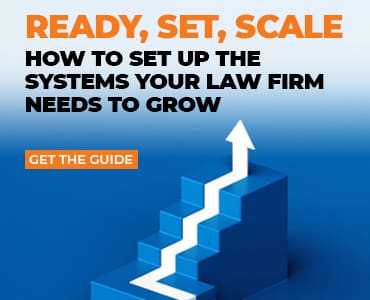For as long as there have been sellers, there has been anxiety over closing a sale. Closing is generally defined as the moment when a prospect or client decides to make the purchase — in the case of lawyers, to engage you for a legal matter.
Here’s how to eliminate the pain and fear.
Risk of Rejection
Closing can be unnerving, especially for inexperienced sellers, because it exposes you to the risk of rejection. As a result, it has become feared as the make-or-break “moment of truth” in the sale.
Ironically, the “moment of truth” concept is the key to eliminating all the tension around closing a sale — for both buyer and seller. The premise is conducting your sales investigation in a way that actually seeks the truth — that is, the truth about whether it’s a good idea for you to do business together, on this matter, right now.
It’s a dichotomy. It’s either a good (enough) idea or not.
Good for You, Maybe Not So Good for Me
Unfortunately, too many sellers focus all their energies on getting to “yes,” in effect denying half of the dichotomy. If you’re trying to get me to “yes,” I know that’s good for you. If I don’t yet know whether it’s good for me, I erect barriers between us to provide me time and space to resolve that question for myself.
Worse, you’ve excluded yourself from the remainder of my investigation because you’ve shown that your sole purpose is to get to “yes.” Since that perspective has already been well represented, you’ve forfeited any pretense of objectivity as I explore the rest of the equation. I already know what you’re willing to contribute, and more of that doesn’t help me, so you’re now on the outside looking in, waiting while I do my thing without you.
Product-Centrism
Such singularly focused sales activity is usually the result of a product-centric approach — that is, one in which you’re pitching the merits of your firm, expertise, experience and so forth. In essence, this is received as, “We’re really good at this. Here’s proof. Therefore, you should hire us.”
Instead, if your approach is based on a problem that prospects of this type generally face, you’re automatically focused on the prospect’s circumstances, challenges and consequences. Your interest is automatically subordinated to that of the buyer, which promotes trust and cooperation.
So Far, So Good
Let’s say that you’ve done a good job so far:
- You discerned a problem that affects most companies in an industry (your door-opener).
- Your prospect has acknowledged that her company experiences that problem now.
- You elicited the prospect’s description of specific consequences associated with it (strategic, operational, economic, personal).
- You helped the prospect convert those into an expression of perceived economic impact (or cost of doing nothing).
- You got the prospect to describe her self-interest — that is, the potential risks and consequences to her career if this problem persists.
- You’ve shown how you can reverse some or all of the negative consequences and produce a specific positive impact, which you’ve helped her express as anticipated economic benefit.
Fear of “The Ask”
At this moment, you’re thinking, “All these pieces fit together perfectly. It’s obvious that we should do this together.” Despite the confidence this should inspire, you’re still paralyzed by the fear of “the ask.” It’s that discomfiting moment of truth when everything is on the line. You have to ask her to hire you, to award you the business. It’s the ultimate sweaty-palms moment.
After all, despite all the stars being so apparently aligned, she might still say “no.”
Instead of asking for a “yes,” subjecting yourself to these risks, why not ask why she wouldn’t proceed with you?
Summarize Your Shared Experience
Begin by summarizing.
You: “It seems like we’ve accomplished a lot here. We’ve defined your problem and its consequences. You’ve attributed $____ (thousands, millions) in economic impact to it, and we’ve got some potential solutions on the table you’re comfortable with, and we seem comfortable with each other. Is that a fair characterization of our discussion?”
There’s no risk here. You both experienced this. There’s little chance that you’re wrong. You’re going to get a “yes” to this. Now, you ask the only question that matters: “What would prevent us from working on this together?” The answer might be “nothing, really.” Then, ask about the mechanics of getting started.
“What Would Prevent Us From Working on This Together?”
However, if there are obstacles to hiring you, you’ll learn what they are — without rejection.
Prospect: “Well, our CEO had a bad experience with a big law firm overbilling. It’ll be hard to convince him that that won’t happen with your firm and you.”
You: “Any other obstacles to our working together?”
Get them all out on the table. Your prospect and you are now working on overcoming them together. You’re not on the outside looking in, waiting anxiously for word from on high.
The principle is that all available information points to “We should do this together.” The key is “available.” She may have information she hasn’t made available to you. She’ll share it if you ask for it. Everything looks good, but she hasn’t hired you, so there must be something impeding that. Ask what it is and solve it together.
Read “Creative Price Negotiation” here.
Illustration ©iStockPhoto.com
Subscribe to Attorney at Work
Get really good ideas every day for your law practice: Subscribe to the Daily Dispatch (it’s free). Follow us on Twitter @attnyatwork.

















